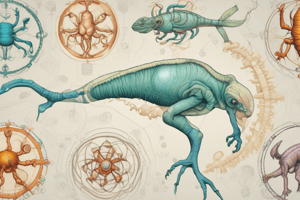Podcast
Questions and Answers
Which of the following is NOT a type of selection that acts upon genetic variations in phenotypes?
Which of the following is NOT a type of selection that acts upon genetic variations in phenotypes?
- Artificial selection
- Environmental selection (correct)
- Sexual selection
- Natural selection
Populations evolve when all members of the population have greater reproductive success than other members.
Populations evolve when all members of the population have greater reproductive success than other members.
False (B)
What generates genetic variation in a population?
What generates genetic variation in a population?
Mutations
Evidence of evolution can be found in both ______ and extinct species.
Evidence of evolution can be found in both ______ and extinct species.
What does molecular evidence for evolution primarily involve comparing?
What does molecular evidence for evolution primarily involve comparing?
According to molecular evidence, humans and chimpanzees share a more recent common ancestor than humans and dogs.
According to molecular evidence, humans and chimpanzees share a more recent common ancestor than humans and dogs.
What are homologous structures?
What are homologous structures?
__________ fossils show intermediate states between ancestral and modern species.
__________ fossils show intermediate states between ancestral and modern species.
Match the following types of evidence with their description:
Match the following types of evidence with their description:
What is the definition of vestigial structures?
What is the definition of vestigial structures?
Flashcards
Genetic Variation
Genetic Variation
Mutations create genetic diversity within a population, leading to varied traits.
Population Evolution
Population Evolution
Populations change over time as traits that enhance reproductive success become more common.
Molecular Evidence
Molecular Evidence
Comparing DNA and protein sequences reveals evolutionary relationships between organisms.
Homologous Structures
Homologous Structures
Signup and view all the flashcards
Fossils
Fossils
Signup and view all the flashcards
Vestigial Structures
Vestigial Structures
Signup and view all the flashcards
Study Notes
- Mutations generate genetic variation in a population
- These genetic variations lead to different phenotypes in a population
- Populations evolve when some members of the population have greater reproductive success than other members of the population
Evidence of Evolution
- Evidence of evolution can be found in extant (living) and extinct species
- Molecular evidence compares DNA sequences and amino acid sequences in proteins from different organisms to provide evidence of evolution
- When comparing the DNA sequence of a gene that is shared by different organisms, the more recently the organisms share a common ancestor, the more similar their DNA sequences will be
- The GAPDH gene in humans and in chimpanzees is over 99% similar in sequence, but the similarity in the GAPDH gene in humans and in dogs is only about 91% similar, indicating that humans and chimpanzees share a more recent common ancestor than humans and dogs
- Molecular evidence is considered very strong evidence since environmental factors do not usually change an organism's DNA sequence
- Morphology which includes homologous structures that have common ancestry but different functions, also provide evidence of evolution
- The number and arrangement of bones in human hands, bat wings, and whale fins are very similar, indicating common ancestry and evidence of evolution
- Fossils from organisms that no longer live on Earth provide evidence of evolution
- Transitional fossils show intermediate states between ancestral and modern species
- Fossils can be dated by studying the age of the rock layers in which they are found or by using radioactive isotopes to date the fossils
- Vestigial structures are anatomical features in some organisms that no longer seem to have a purpose in the modern organism but may have had a function in an ancestral organism
Studying That Suits You
Use AI to generate personalized quizzes and flashcards to suit your learning preferences.



